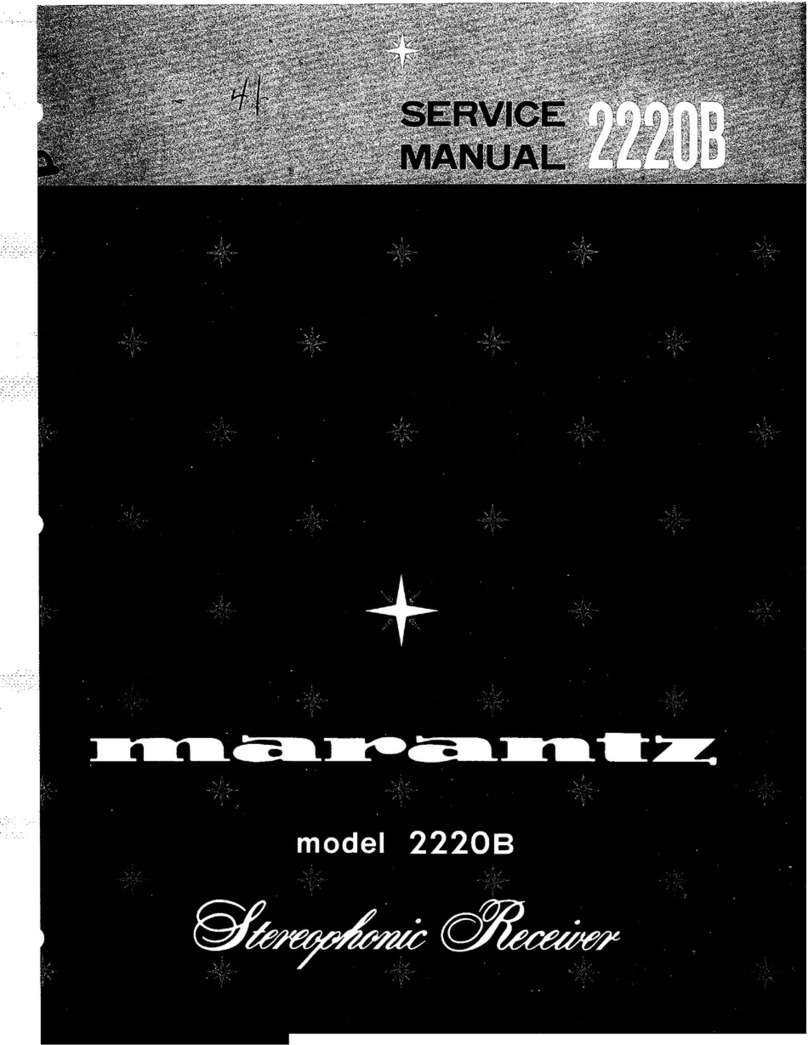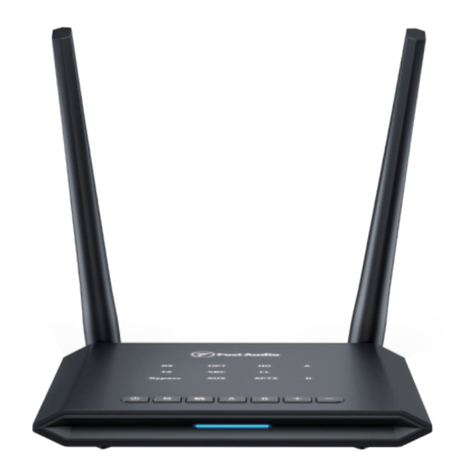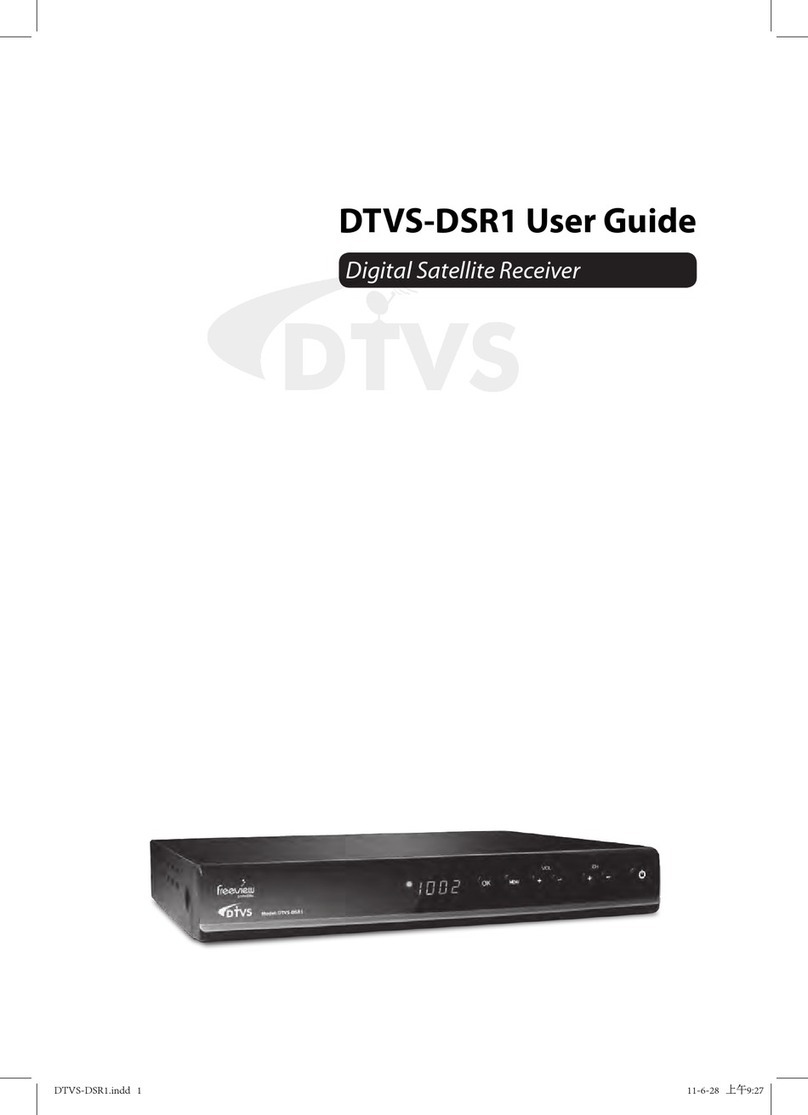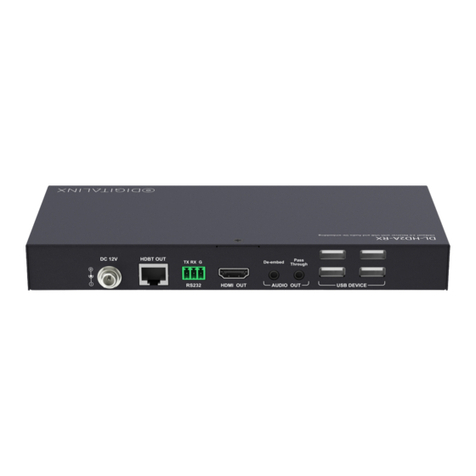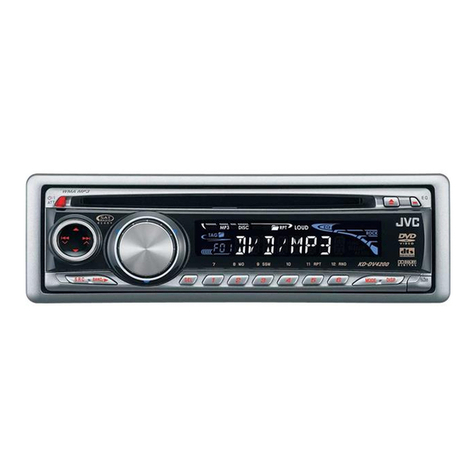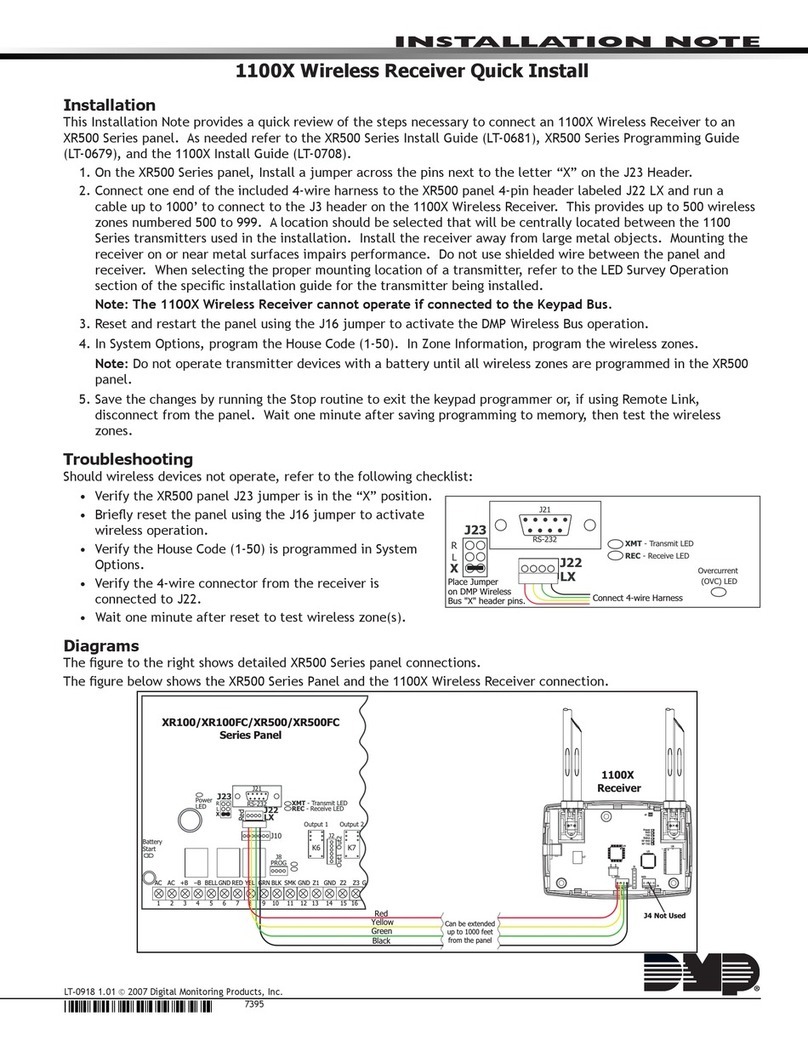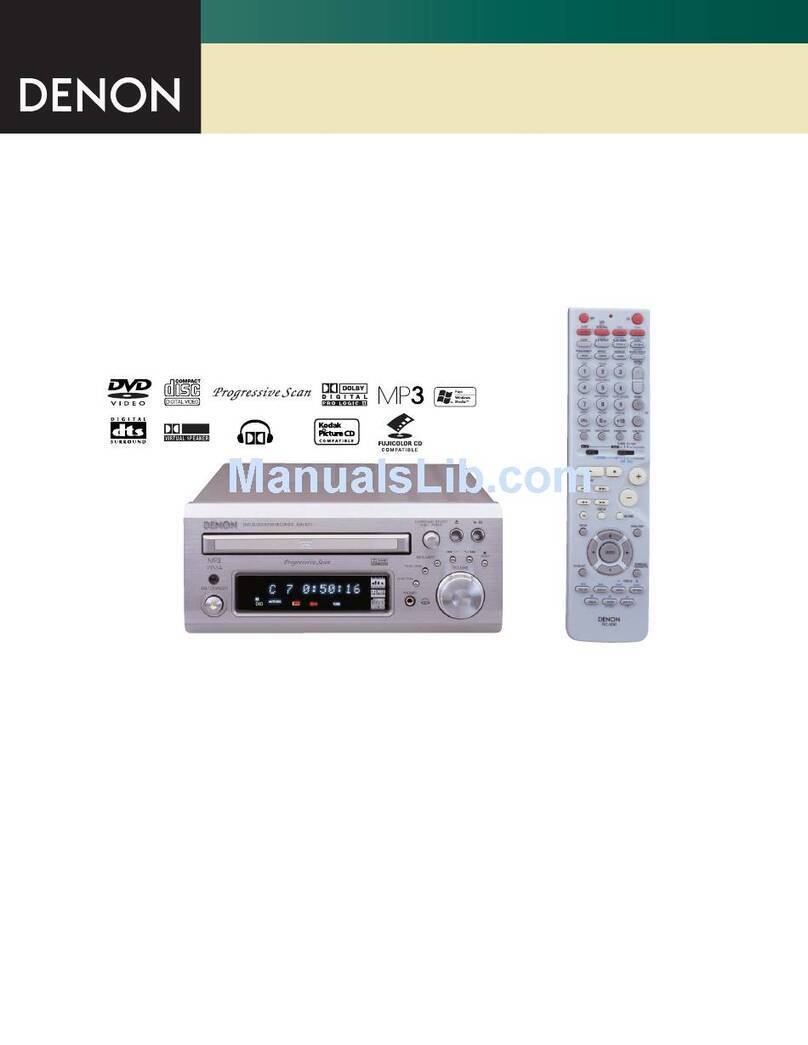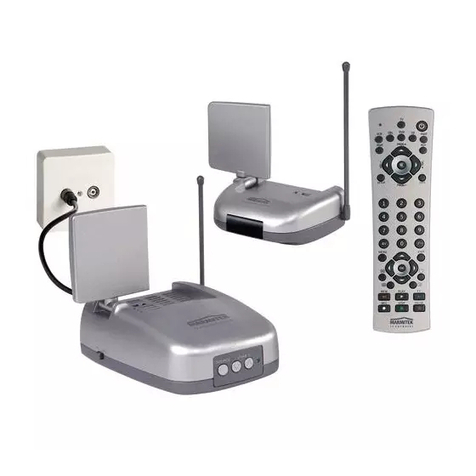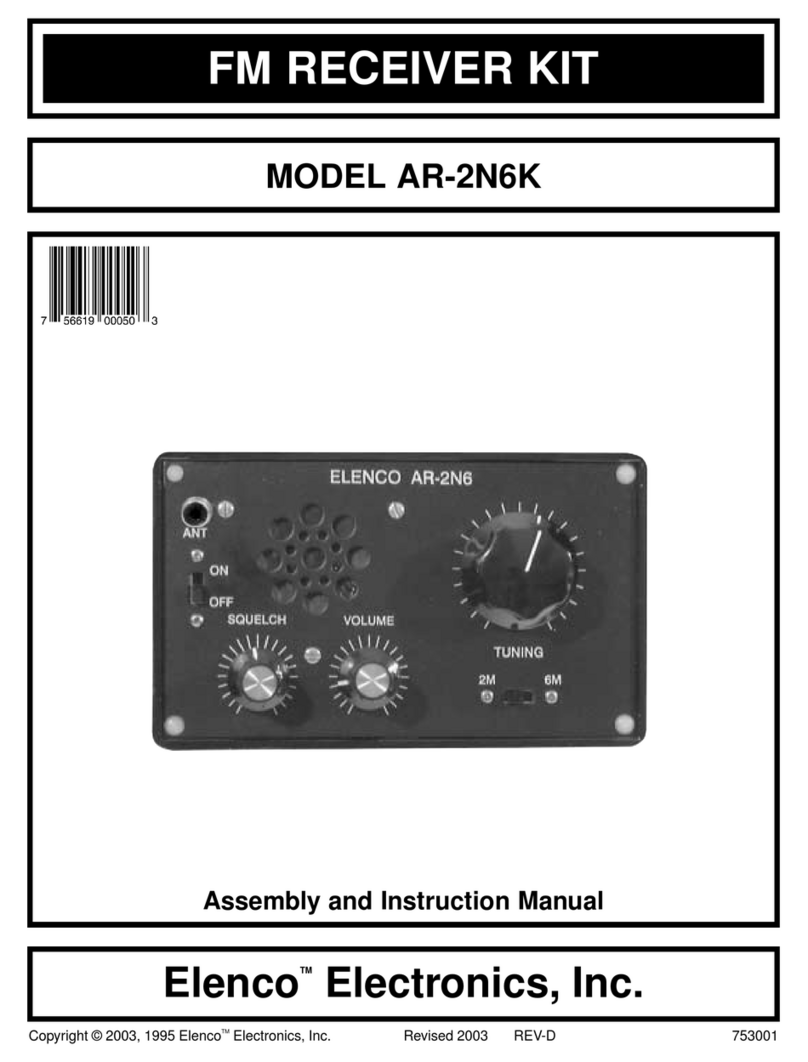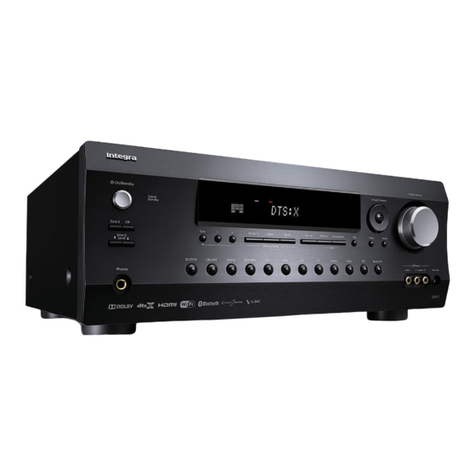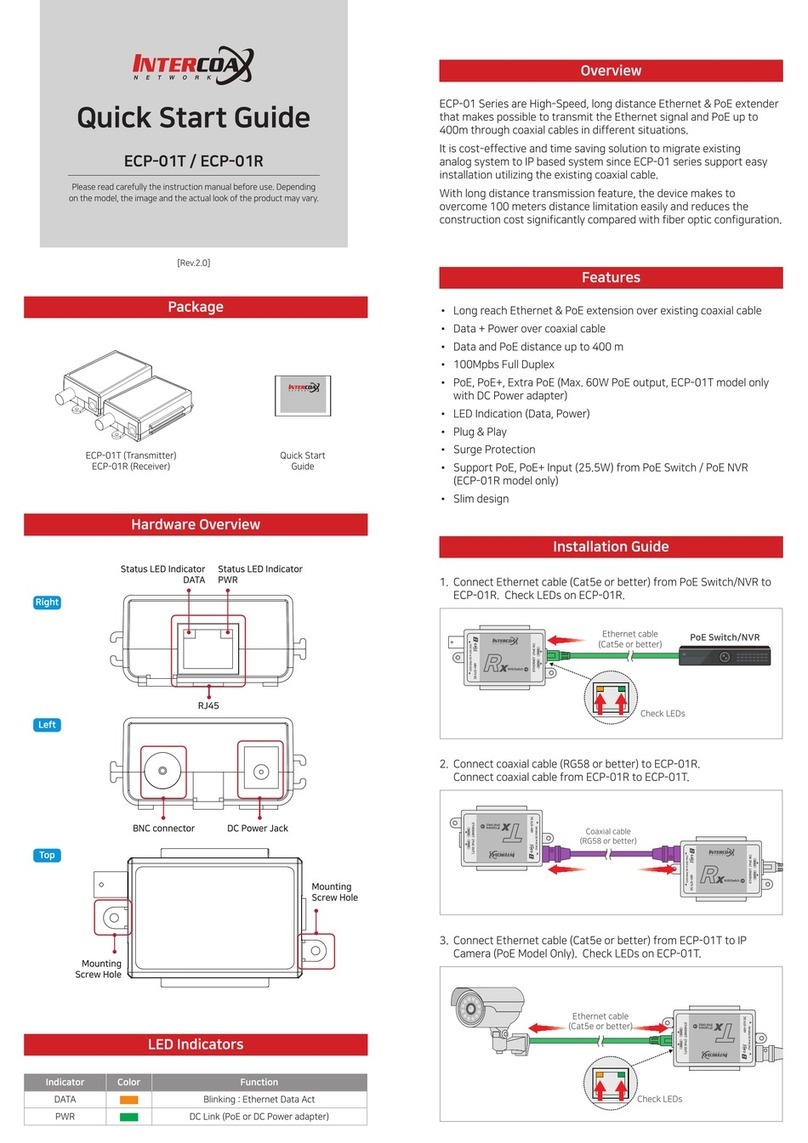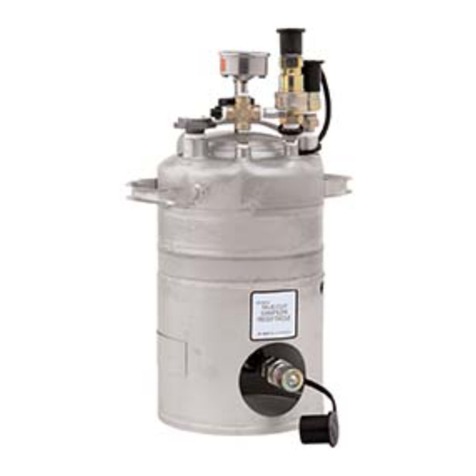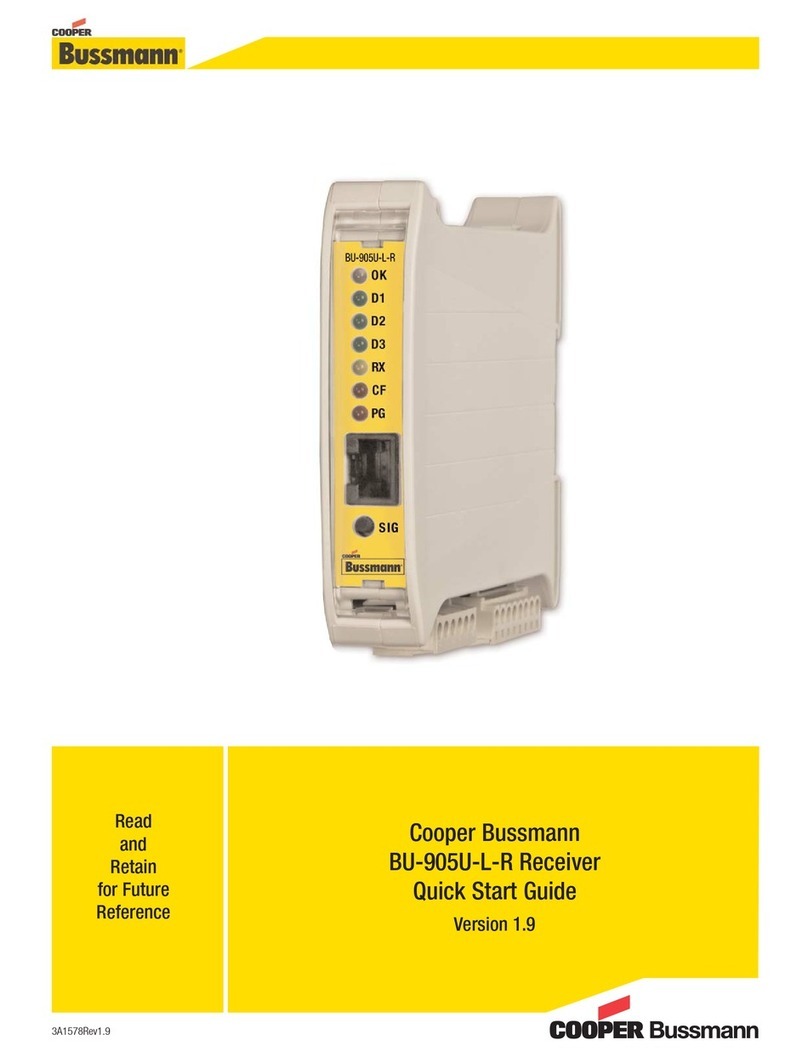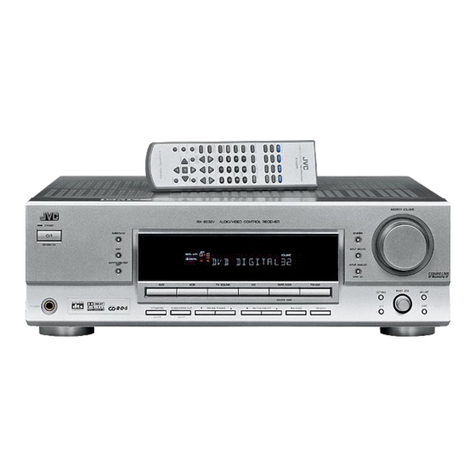Technisonic Industries Limited TiL-92-SC User manual

VHF/AM
SINGLE CHANNEL
RECEIVER
MODEL TiL-92-SC
92-SC RECEIVER, P/N 931040-1
(ITEM NO. TSR-4100)
Installation and
Operating Instructions
Til Document No.
93RE125
Rev. D
October 2002
Technisonic Industries Limited
240Traders Blvd., Mississauga, Ontario L4Z 1W7 Tel:(905)890-2113 Fax:(905)890-5338
www.til.ca

CAUTION
This unit contains static sensitive devices. Wear a grounded wrist strap and/or conductive
gloves when handling printed circuit boards.
WARRANTY INFORMATION
The Model 92-SC series, Single Channel rack mounted receiver, is under warranty for one
year from date of purchase. Failed units caused by defective parts, or workmanship
should be returned to:
Technisonic Industries Limited
240 Traders Blvd.
Mississauga, Amherst, NY, USA
Ontario L4Z 1W7
Tel: (905) 890-2113 Tel: (716) 691-0669
Fax: (905)890-5358
A Page

TABLE OF CONTENT
Paragraph Title Page
SECTION 1
GENERAL DESCRIPTION
1.1 Introduction .................................................................. 1-1
1.2 Description ................................................................... 1-1
1.2.1 Receiver Module .............................................................. 1-2
1.2.2 Power Supply Module - Model SPG-007 ........................................... 1-2
1.2.3 MotherBoard ................................................................. 1-2
1.2.4 RemoteAudioBoard ........................................................... 1-2
1.2.5 CrystalFilter(Option1) ......................................................... 1-3
1.3 Modes of Operation ............................................................ 1-3
1.3.1 Local/RemoteOperation ........................................................ 1-3
1.3.2 AC and DC Operation .......................................................... 1-3
1.4 Technical Summary ........................................................... 1-3
SECTION 2 PREPARATION FOR USE AND STORAGE
2.1 Introduction ................................................................... 2-1
2.2 Disassembly/Assembly.......................................................... 2-1
2.2.1 Remove/ReplaceCoverAssembly ................................................ 2-1
2.2.2 Remove/Replace Receiver Module ................................................ 2-1
2.2.3 Remove/Replace Memory Set Board Module A5A1 ................................... 2-3
2.2.4 Remove/ReplaceAudioBoard.................................................... 2-3
2.2.5 Remove/ReplaceCrystalFilterBoard .............................................. 2-5
2.3 Channel Frequency Selection .................................................... 2-5
2.3.1 Introduction ................................................................... 2-5
2.3.2 Frequency Range .............................................................. 2-5
2.3.3 Pre-Programming Channel Frequency ............................................ 2-5
2.3.4 Offset Frequency Set ........................................................... 2-6
2.4 RemoteOperationSetUp ....................................................... 2-9
2.4.1 Remote Audio Board P/N 923060-1 ............................................... 2-9
2.5 Optional Loudspeaker, Headphone Installation ..................................... 2-11
2.5.1 External Loudspeaker .......................................................... 2-11
2.5.2 Headset ..................................................................... 2-11
2.6 Receiver Adjustments and Settings .............................................. 2-11
2.7 Operational Check ............................................................ 2-11
2.8 Storage ..................................................................... 2-11
i

TABLE OF CONTENTS (Continued)
Paragraph Title Page
SECTION 3 OPERATING INSTRUCTIONS
3.1 Introduction ................................................................................ 3-1
3.2 Installation ................................................................................. 3-1
3.3 Operator's Switches, Controls and Indicators ..................................................... 3-1
3.4 OperatingInstructions ........................................................................ 3-4
3.4.1 Receiver Operation (Local Mode) .............................................................. 3-4
3.4.2 SwitchingOFF .............................................................................. 3-5
3.4.3 ExternalDCOperation ....................................................................... 3-5
LIST OF TABLES
Table No. Title Page
1-1 92-SC Leading Particulars .....................................................................1-4
2-1 Frequency Selection MHz .....................................................................2-7
2-2 Frequency Selection KHz ......................................................................2-8
2-3 Remote Connector Functions ..................................................................2-9
3-1 Operator's Switches, Controls and Indicators ......................................................3-3
LIST OF ILLUSTRATIONS
Figure No. Title Page
1-1 VHF/AM Single Channel Receiver ...............................................................1-1
2-1 Single Channel Receiver - Internal View ..........................................................2-2
2-2 Single Channel Memory Set Board - Module A5A1 .................................................2-4
2-3 Remote Audio Board P/N 923061-1 ............................................................2-10
2-4 Receiver Adjustments and Settings .............................................................2-12
3-1 Single Channel Receiver Controls and Indicators ...................................................3-2
ii

1-1
SECTION 1
GENERAL DESCRIPTION
1.1 INTRODUCTION
This publication provides general information on the VHF/AM Single Channel Receiver Model TiL-92-SC, Part No.
931040-1, manufactured by Technisonic Industries Limited. This unit is also referred to by Item No. TSR-4100.
The Model TiL-92-SC, Receiver is a single channel, fixed frequency receiver operating over the frequency range of
117.975 MHz to 138.000 MHz. This unit is intended for base station operation in an air traffic environment. The unit
can operate from AC power or external DC power in local and remote operating modes.
1.2 DESCRIPTION
The 92-SC rack mounted receiver configuration is based on the Model 90-6R pre-programmable transceiver
module. This module, as modified for receiver only capability utilizes similar circuitry as the 90-6R with appropriate
deletion of transmitter functions. In addition to this modified transceiver module, the receiver consists of a Power
Supply Module, Mother Board, and Remote Audio Board.
An optional RF Crystal Filter which provides higher receiver selectivity is available. These filters can be ordered to
provide either an additional 20dB (4 dB loss sensitivity) or 40dB (7 dB loss) of selectivity.
An Optional Module A6 which is a DC to DC power supply is available in the 90-6R Receiver unit. This optional
power supply will allow the 92-SC Receiver to operate with a 24 Vdc input as opposed to the standard 12 Vdc input.
When the units are operating in the AC mode and external batteries are connected a DC charging circuit will
automatically trickle charge the batteries and the unit will switch to DC operation should the AC mains fail.
Figure 1-1 VHF/AM Single Channel Receiver

1-2
1.2 DESCRIPTION (continued)
To improve the rejection of interfering signals, dual conversion receiver technology has been incorporated
on the Receiver (Module A1) board used in Technisonic VHF/AM base stations. The second IF is 455kHz
using a ceramic filter, which is immune to high energy ringing. The dual conversion module also has a
second local oscillator, second mixer and ceramic filter. The first local oscillator is the original VCO.
The dual conversion receiver board, P/N 003494-3 was implemented into TSR series base stations starting in
January 2001. An option label on the chassis will indicate OPTION 94 if the dual conversion board is installed. It is
possible to retro-fit the dual conversion receiver board into older TSR series base station employing the single
conversion board. Please contact Technisonic for availability of an exchange board. Note: If a new A1 Module
has been retrofitted the squelch circuit must be aligned for the receiver squelch to operate correctly.
The dual conversion receiver’s squelch knob must be rotated significantly more clockwise (4 o’clock
position) to obtain the same squelch setting (3uV) as a single conversion receiver’s squelch knob set to the
12 o’clock (straight up) position.
If the dual conversion receiver’s squelch knob is set to the 12 o’clock position, signals with a level greater
than 0.5uV will open the squelch. At most airports this will not be an adequate level of squelch. Please be
aware of this squelch knob adjustment variance when setting and/or comparing squelch levels of dual
conversion vs. single conversion base stations.
1.2.1 Receiver Module
The Single Channel Receiver is based on Transceiver Model 90-6R. The transceiver module is modified for receive
only, on one pre-programmable synthesized frequency, with 25kHz channel spacing in the frequency range
117.975 MHz to 138.000 MHz. The single channel memory set board, module A5A1 is mounted external to the
receiver internal module to facilitate ease of frequency programming. Refer to above paragraph for details on new
dual conversion receiver A1module.
1.2.2 Power Supply Modules - Model SPG-007
The Power Supply Module, Model SPG-007 provides the DC supply voltage to the receiver and houses a battery
charger which can provide charging and trickle charging to an external rechargeable 12 Vdc battery, if utilized.
1.2.3 Mother Board
The Mother Board provides all interconnection between the two external remote control connectors, Power Supply,
Remote Audio Board, and Receiver module. The Remote Audio Board, Optional Crystal Filter and all internal fuses
are mounted on the Mother Board.
1.2.4 Remote Audio Board
1. Line Interface Board P/N 923060-1
NOTE This board is supplied modified for the 92-SC, Receiver without transmitter keying functions
Provides remote receiver audio monitoring over 2 wire 600 ohm audio lines.

1-3
1.2.5 Crystal Filter Board Assembly P/N 923069-1 (Option 1)
The Crystal Filter is a 25 KHz bandpass filter which provides additional selectivity during receive operation. The
filter provides 5 dB (MAX) attenuation of RF signals ± 7.5 KHz from the receive frequency and 20 dB (MIN)
attenuation of RF signals ± 50.0 KHz from the receive carrier frequency. This item is interchangeable in the field.
Refer to Paragraph 2.2.5 for replacement instructions. If no crystal filter option is ordered, jumper board assembly
P/N 923074-1 is installed. P/N 923069-2 will provide 40dB attenuation of RF signals ± 50.0 KHz from the receive
carrier frequency with a 7dB loss in sensitivity as opposed to a 4dB loss for the 20dB filter.
1.3 MODES OF OPERATION
1.3.1 Local/Remote Operation
The Single Channel receiver can be operated in Local or Remote modes.
NOTE
Local operation is not disabled when operating in
Remote mode and Remote operation is not disabled
when operating in Local mode. The two operating
modes operate in parallel.
1. LOCAL OPERATION - In local operation, receive audio is routed to the internal loudspeaker
and phone jack located on the front panel.
2. REMOTE OPERATION - In Remote operation, receive audio functions are routed over land
lines to the 600 ohm remote inputs. Receive audio is routed to the internal loudspeaker and is
adjustable by the volume control.
1.3.2 AC and DC Operation
The unit can be operated by external 120/220 VAC or external 13.7 Vdc (24 Vdc Optional).
1. AC OPERATION - During AC operation, the unit can charge and trickle charge external
batteries via the external connectors mounted on the rear panel of the unit. Refer to Table 1-2 for
details.
2. DC OPERATION - The unit can be operated from an external DC supply within the range of
11.5 Vdc to 15.0 Vdc. Note: If optional Module A6 is ordered the unit can be operated within the
supply range of 21.7 to 30.0 Vdc.
1.4 TECHNICAL SUMMARY
A summary of electrical, operational, mechanical and physical characteristics of the Single Channel
Receiver are provided in Table 1-1.

1-4
TABLE 1-1 LEADING PARTICULARS
POWER REQUIREMENTS:
AC Input Voltage/Current .................................100 to 132 VAC @ 1.0 Amp(nominal)
AC Input Voltage/Current (selectable by jumper) ............. 190 to 250 VAC @ 0.7 Amp (nominal)
DC Input Voltage/Current ............................ 11.5VDCto15VDC@3.5Amp(nominal)
If Optional Module A6 ordered ....................... 21.7VDCto30VDC@2.0Amp(nominal)
Battery Charger Voltage & Current................................... 13.75Vdc,3.5AmpsMAX
If Optional Module A6 Ordered ..................................... 27.5Vdc,2.0AmpsMAX
Remote RX Audio:
Range ......................................... +10dBmto-15dBm(Factorysetto-10dBm)
Impedance ............................................. 600 Ωfloating with respect to ground
RX Interface Signals:
Squelch Signal ................................................ Ground, Open circuit for Mute
AGC Signal Output ..................................................... Linear 0 to +6 Vdc
Temperature & Humidity:
Operating Temperature Range ................................ -25EC(-13EF) to +55EC(+131EF)
Storage Temperature Range .................................. -55EC(-67EF) to +65EC(+149EF)
Relative Humidity (non-condensing) ................................................... 100%
Dimensions & Weight (Single Channel Receiver Chassis):
Width ............................................................. 483 mm (19.0 in) MAX
Height............................................................... 89mm(3.5in)MAX
Depth ............................................................. 432 mm (17.0 in) MAX
Weight .............................................................. 5.5Kg(12lbs)MAX
90-6R RECEIVER INTERNAL MODULE:
Dimensions & Weight:
Width .............................................................. 216 mm (8.5 in) MAX
Height.............................................................. 70mm(2.75in)MAX
Depth ............................................................ 260 mm (10.25 in) MAX
Weight ........................................................... 1.8Kg(3lb15oz)MAX

1-5
TABLE 1-1 LEADING PARTICULARS (Continued)
RECEIVER PERFORMANCE SPECIFICATIONS:
RF Input Impedance ............................................. 50Ω, VSWR 2:1 MAX
Sensitivity(12dBSINAD)@1KHz30%Mod ..................................1.5µvolts
Selectivity, 25 KHz Channel Spacing:
6 dB Bandwidth .................................................GreaterThan 14 KHz
80 dB Bandwidth .................................................. LessThan 50 KHz
Adjacent Channel Selectivity ....................................... GreaterThan 85 dB
Spurious Response Attenuation .....................................Greaterthan 95 dB
Frequency Stability (-40EC to +55EC) ................................... ±1,000 Hz MAX
RFAGC(5µvoltsto1volt) ................................ AudioLeveloflessthan 3 dB
Intermodulation:
UltimateSensitivity ...........................................................70dB
30µvolts ...................................................................45dB
300 µvolts ..................................................................30dB
UnwantedRadiation .......................................Lessthan 80 µvolts into 50 Ω
Hum&Noise@1mVRF30%MOD.............................................40dB
Loudspeaker Output .......................................................3WMAX
Phone Output ................................................... 100 mW into 600 Ω
AudioDistortion1mVRFInput,30%MOD ..................................... 3%MAX
AudioDistortion1mVRFInput,90%MOD ..................................... 5%MAX
AudioOutputLimiting .................................Lessthan 1 dB @30 to 100% MOD
Audio Frequency Response 300 Hz-2500 Hz .................................. +1,-3dB
AudioAcquisitionTime ............................................ Lessthan 50 msecs
Audio Squelch Characteristics:
Squelch Type .............................................Noiseand Carrier Operated
Carrier Operated Squelch ..................................... Adjustable2to15µvolts

2-1
SECTION 2
PREPARATION FOR USE AND STORAGE
2.1 INTRODUCTION
This section provides the information required for custom configuration and storage of the Single
Channel Receiver. Custom system configuration includes adjusting receive audio board functions,
and Receive frequency selection.
2.2 DISASSEMBLY / ASSEMBLY (Refer to Figure 2-1)
2.2.1 Remove / Replace Top Dust Cover Assembly
REMOVAL
(1) Remove and retain twelve screws securing top dust cover to the 19" rack chassis.
(2) Please note the location of the three longer screws which travel through the heatsink shims
rivetted to the inside of the top cover.
(3) Lift cover clear of chassis to expose internal view of receiver as shown in Figure 2-1.
REPLACEMENT
(1) Position top cover on chassis.
(2) Position one screw in each corner of the top cover mounting holes. Place the three longer
screws into their correct holes located over the internal receiver module.
(3) Secure cover to chassis with remaining screws.
2.2.2 Remove/Replace Receiver Module
REMOVAL
(1) Remove dust cover as described in paragraph 2.2.1.
(2) Disconnect RF and DC connectors from rear of receiver module.
(3) Remove and retain the screws securing the top cover of the internal receiver module.
(4) Remove and retain two screws and two washers securing flat cable to the side of the receiver
module and disconnect the flat cable. Disconnect the flat cable running out of the receiver module
at the connector on the external memory set board.
(5) Remove and Retain four countersunk screws securing receiver module to front panel.

2-2
Figure 2-1 Single Channel Receiver - Internal View

2-3
(6) Move the receiver module slightly back from the front panel and disconnect the flat cable
connecting the front panel assembly to the transceiver module, audio interface board A3. The
connector is located on the A3 board.
(7) Lift receiver module clear of chassis.
REPLACEMENT
(1) Position the receiver module into the chassis. While holding the receiver module slightly back from
the front panel, re-connect the flat cable from the front panel to the A3 board in the receiver
module.
(2) Position and secure receiver module to front panel with four countersunk screws.
(3) Connect flat cable to receiver module. Secure flat cable to receiver module with two screws and
two washers. Connect flat cable running out of the receiver module to the external memory set
board.
(4) Connect DC and RF connectors to rear of receiver module.
(5) Replace and secure the top cover of the receiver module with the screws removed in step
(3) of the REMOVAL instructions.
(6) Replace top dust cover as described in paragraph 2.2.1.
2.2.3 Remove Replace External Single Channel Memory Set Module A5A1
REMOVAL
(1) Remove dust cover as described in paragraph 2.2.1.
(2) Remove and retain four screws securing Memory Set Board, Module A5A1 "piggy back" to
the standoffs on the power supply cover. (See Figure 2-1 for location)
REPLACEMENT
(1) Secure the Memory Set Module to the stand-offs located on the power supply cover by the
four screws.
2.2.4 Remove/Replace Audio Board
REMOVAL
(1) Remove dust cover as described in paragraph 2.2.1.
CAUTION Care must be taken when removing or replacing Control Board to avoid
damage to Motherboard Connector Pins.
(2) Remove and retain four screws securing Audio Board "piggy back" to the Mother Board
standoffs. Remove Audio Board from Mother Board.

2-4
Figure 2-2 Single Channel Memory Set Board
Module A5A1

2-5
REPLACEMENT
(1) Align the two female connectors on the control board with the male connectors on the
Mother Board using the four mounting holes and standoffs as a guide. Secure control board to the
Mother Board standoffs with four screws and washers.
(2) Replace dust cover as described in paragraph 2.2.1.
2.2.5 Remove/Replace Crystal Filter Board
REMOVAL
(1) Remove dust cover of unit as described in Paragraph 2.2.1.
(2) Remove and retain the four screws securing the crystal filter board assembly, P/N 923069-1
to the standoffs on the Frequency-Set Memory Board. Pull the crystal filter board assembly
straight up to avoid damaging the Frequency-Set Memory Board connector pins.
REPLACEMENT
(1) Align the pins on the bottom of the crystal filter board with their sockets on the Mother Board.
Push the crystal filter board straight down until it rests on the Mother Board standoffs.
(2) Secure the crystal filter board to the standoffs with the four mounting screws.
NOTE: Make certain that the memory set board, module A5A1 is programmed to the same
operating frequency as the crystal filter board assembly. If no crystal filter board assembly (option)
is installed, jumper board assembly P/N 923074-1 must be installed.
2.3 CHANNEL FREQUENCY SELECTION
2.3.1 Introduction
Before programming a new operating frequency, perform an operational check, as outlined in
Section 3. If there is any operational deficiency or equipment malfunction, return receiver to the
manufacturer. Before use it is necessary to pre-program the operating frequency.
2.3.2 Frequency Range
The operating frequency may be programmed over the frequency range 117.975 MHz to 138.000
MHz with 25kHz channel spacing.
2.3.3 Pre-programming Channel Frequency
Determine the operating frequency to be programmed and proceed as follows:
FREQUENCY SELECTION MHz.
Refer to Table 2-1 Frequency Selection MHz. Using the OPERATING FREQUENCY (MHz)
column, find the desired frequency in MHz. Cross-refer to the JUMPER LOCATION column, and
install the jumper as required.

2-6
FREQUENCY SELECTION KHz
Refer to Table 2-2, Frequency Selection kHz. Using the OPERATING FREQUENCY kHz column, find the
portion of the desired frequency in kHz. Cross-refer to the JUMPER LOCATION column, and install the
jumpers in the locations as required.
2.3.4 Offset Frequency Set
(A) Jumper J15, located on the single channel memory set board, module A5A1 selects the
frequency offset as follows:
(1) If J15 is not installed, frequency offset is inhibited.
(2) If J15 is installed in the Rx position, the receive frequency will be offset low.
(3) If J15 is installed in the Tx position, the receive frequency will be offset high.
(B) Trim capacitors C16 and C37, accessible from the bottom of the unit (see Figure 2-6), are
used to accurately adjust the receive frequency.

2-7
TABLE 2-1 FREQUENCY SELECTION MHz
OPERATING
FREQUENCY
(MHz)
JUMPER LOCATION
20 MHz 10 MHz 8 MHz 4 MHz 2 MHz 1 MHz
117
118
119
120
121
122
123
124
125
126
127
128
129
130
131
132
133
134
135
136
137
138
0
0
0
1
1
1
1
1
1
1
1
1
1
1
1
1
1
1
1
1
1
1
1
1
1
0
0
0
0
0
0
0
0
0
0
1
1
1
1
1
1
1
1
1
0
1
1
0
0
0
0
0
0
0
0
1
1
0
0
0
0
0
0
0
0
0
1
0
0
0
0
0
0
1
1
1
1
0
0
0
0
0
0
1
1
1
1
0
1
0
0
0
0
1
1
0
0
1
1
0
0
0
0
1
1
0
0
1
1
0
1
0
1
0
1
0
1
0
1
0
1
0
1
0
1
0
1
0
1
0
1
0
LEGEND:
0 = JUMPER BETWEEN CENTRE AND 0 1 = JUMPER BETWEEN CENTRE AND 1

2-8
TABLE 2-2 FREQUENCY SELECTION KHz
OPERATING
FREQUENCY
(KHz)
DIODE LOCATION
800 KHz 400 KHz 200 KHz 100 KHz 50 KHz 25 KHz
000
025
050
075
100
125
150
175
200
225
250
275
300
325
350
375
400
425
450
475
500
525
550
575
600
625
650
675
700
725
750
775
800
825
850
875
900
925
950
975
0
0
0
0
0
0
0
0
0
0
0
0
0
0
0
0
0
0
0
0
0
0
0
0
0
0
0
0
0
0
0
0
1
1
1
1
1
1
1
1
0
0
0
0
0
0
0
0
0
0
0
0
0
0
0
0
1
1
1
1
1
1
1
1
1
1
1
1
1
1
1
1
0
0
0
0
0
0
0
0
0
0
0
0
0
0
0
0
1
1
1
1
1
1
1
1
0
0
0
0
0
0
0
0
1
1
1
1
1
1
1
1
0
0
0
0
0
0
0
0
0
0
0
0
1
1
1
1
0
0
0
0
1
1
1
1
0
0
0
0
1
1
1
1
0
0
0
0
1
1
1
1
0
0
0
0
1
1
1
1
0
0
1
1
0
0
1
1
0
0
1
1
0
0
1
1
0
0
1
1
0
0
1
1
0
0
1
1
0
0
1
1
0
0
1
1
0
0
1
1
0
1
0
1
0
1
0
1
0
1
0
1
0
1
0
1
0
1
0
1
0
1
0
1
0
1
0
1
0
1
0
1
0
1
0
1
0
1
0
1
LEGEND:
0 = JUMPER BETWEEN CENTRE AND 0 1 = JUMPER BETWEEN CENTRE AND 1

2-9
2.4 REMOTE OPERATION SETUP
The Procedures listed below enable the user to custom configure the unit for external remote audio
monitoring hardware or a remote consoles. Refer to Table 2-3 for connector pin details on Remote
Control D Connector located at rear of Single Channel Receiver. Refer to Figure 2-3 for board
location. Verify remote audio control/operation in accordance with manufacturers instructions.
CAUTION
This unit contains static sensitive devices. Wear a
ground strap and/or conductive gloves when
handling printed circuit boards.
TWO WIRE SETUP - In two wire operation, a single balanced 600 ohm pair is provided for
receive audio.
TABLE 2-3 REMOTE CONNECTOR FUNCTIONS
9 PIN
NO
25 PIN
NO
Connector Pin Functions
A,B
C,D
H
N/A
K
J
N/A
E(-),F(+)
N/A
N/A
9,21
10,22
12,24
8
13
1,2,14,15
25
23(-),11(+)
20
3,4,5,6,7,16,17,
18, 19
2 Wire Rx Audio Line (600 Ω)
Not Connected
External DC In (+12 Vdc) or 24Vdc if module A6 ordered.
AGC
Not Connected
Ground
Squelch
Not Connected
Not Connected
Not Connected, allocated for future functions
2.4.1 Remote Audio Board P/N 923060-1
There is one board in this family, which is used for both receiver and transmitter applications. This
board provides remote audio monitoring of receiver operation on 2 wire 600 ohm lines.
Figure 2-3 illustrates P/N 923060-1. R18 Sets Rx Audio OUT Level (Range -15 dBm to +10 dBm)
and all other variable resistors and jumpers are not utilized for receiver application. ie/ Variable
resistors R12 and R32 along with Jumpers J1, J2 and J3 (all of which control TX functions) are
located on the 923060-1 board but will not have any function when used in the TSR-4100 receiver.

2-10
Figure 2-3 Remote Audio Board P/N 923060-1

2-11
2.5 OPTIONAL LOUDSPEAKER, HEADPHONE INSTALLATION
Provision is made for connection of an external loudspeaker or headphone to the
SPEAKER/PHONE jack of the receiver, as shown in Figure 3-1.
2.5.1 External Loudspeaker
When an external loudspeaker is to be installed, an 8-ohm nominal impedance loudspeaker
should be used. The loudspeaker cable should be terminated by a 1/4 in., 3-pole telephone plug
(male), with the loudspeaker connected between tip and sleeve (ground). Insert the external
loudspeaker connector into the SPEAKER/PHONE jack located on the front panel of the
transceiver. When the external loudspeaker is connected to the transceiver SPEAKER/PHONE
jack, the internal loudspeaker is automatically disconnected.
2.5.2 Headset
Headset impedance should be 150 to 600 ohms. The headset cable must terminate in a 1/4
in. 3-pole telephone plug (male), to mate with the SPEAKER/PHONE jack located on the front
panel of the receiver. The internal loudspeaker is automatically disconnected. Connect the
headset as indicated below for receiver audio.
(1) HEADSET WITHOUT TRANSMIT AUDIO - When receiver audio only without transmit
audio is required, the headset should be connected between the tip and sleeve (ground)
of the telephone plug.
2.6 RECEIVER ADJUSTMENTS AND SETTINGS
The locations at which certain receiver settings and adjustments can be performed are shown in
Figure 2-6. The top dust cover of the receiver must be removed as described in paragraph 2.2.1
to access the AGC, and Squelch settings. The plastic plugs must be removed prior to adjustment
of the remaining settings which are accessed from the bottom of the receiver chassis. If alignment
procedures for these settings are required please consult the manufacturer.
2.7 OPERATIONAL CHECK
Perform an operational check of the receiver after all adjustments. Ensure that the receiver
operates using the Operating Instructions given in Section 3 of this document and the appropriate
specified operating procedures for use with a Remote Audio Monitoring Unit.
2.8 STORAGE
To store for an extended period, store unit in a dry place, in the original shipping container.
Other manuals for TiL-92-SC
1
Table of contents

